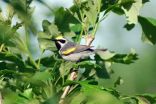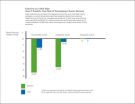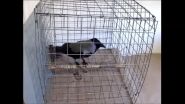Birds sensed severe storms and fled before tornado outbreak
2014-12-18
(Press-News.org) Golden-winged warblers apparently knew in advance that a storm that would spawn 84 confirmed tornadoes and kill at least 35 people last spring was coming, according to a report in the Cell Press journal Current Biology on December 18. The birds left the scene well before devastating supercell storms blew in.
The discovery was made quite by accident while researchers were testing whether the warblers, which weigh "less than two nickels," could carry geolocators on their backs. It turns out they can, and much more. With a big storm brewing, the birds took off from their breeding ground in the Cumberland Mountains of eastern Tennessee, where they had only just arrived, for an unplanned migratory event. All told, the warblers travelled 1,500 kilometers in 5 days to avoid the historic tornado-producing storms.
"The most curious finding is that the birds left long before the storm arrived," says Henry Streby of the University of California, Berkeley. "At the same time that meteorologists on The Weather Channel were telling us this storm was headed in our direction, the birds were apparently already packing their bags and evacuating the area."
The birds fled from their breeding territories more than 24 hours before the arrival of the storm, Streby and his colleagues report. The researchers suspect that the birds did it by listening to infrasound associated with the severe weather, at a level well below the range of human hearing.
"Meteorologists and physicists have known for decades that tornadic storms make very strong infrasound that can travel thousands of kilometers from the storm," Streby explains. While the birds might pick up on some other cue, he adds, the infrasound from severe storms travels at exactly the same frequency the birds are most sensitive to hearing.
The findings show that birds that follow annual migratory routes can also take off on unplanned trips at other times of the year when conditions require it. That's probably good news for birds, as climate change is expected to produce storms that are both stronger and more frequent. But there surely must be a downside as well, the researchers say.
"Our observation suggests [that] birds aren't just going to sit there and take it with regards to climate change, and maybe they will fare better than some have predicted," Streby says. "On the other hand, this behavior presumably costs the birds some serious energy and time they should be spending on reproducing." The birds' energy-draining journey is just one more pressure human activities are putting on migratory songbirds.
In the coming year, Streby's team will deploy hundreds of geolocators on the golden-winged warblers and related species across their entire breeding range to find out where they spend the winter and how they get there and back.
"I can't say I'm hoping for another severe tornado outbreak," Streby says, "but I am eager to see what unpredictable things happen this time."
INFORMATION:
Current Biology, Streby et al.: "Tornadic Storm Avoidance Behavior in Breeding Songbirds"
[Attachments] See images for this press release:


ELSE PRESS RELEASES FROM THIS DATE:
2014-12-18
Many recent studies showed that calorie restrictions reduce the incidence of cancer, whereas high-calorie diets cause obesity and diabetes, both of which increase the risk of developing cancers. However, tumor biology still hides complex mechanisms, as revealed by researchers from the Faculty of Medicine of the University of Geneva (UNIGE), Switzerland. In a study published in Cell Metabolism, scientists not only found the unexpected benefit that a change of diet had on certain types of lung cancer, they also deciphered the molecular mechanism underlying this dietary effect ...
2014-12-18
Berkeley -- When birds unexpectedly flee their nesting grounds, it may be a demonstration of Mother Nature's early-warning system that a massive storm is approaching.
While tracking a population of golden-winged warblers, a research team led by ecologist Henry Streby at the University of California, Berkeley, discovered that birds in the mountains of eastern Tennessee fled their breeding grounds one to two days ahead of the arrival of powerful supercell storms. The storm system swept through the central and southern United States in late April 2014, generating 84 confirmed ...
2014-12-18
This news release is available in Japanese. Behind all motor, sensory and memory functions, calcium ions are in the brain, making those functions possible. Yet neuroscientists do not entirely understand how fast calcium ions reach their targets inside neurons, and how that timing changes neural signaling. Researchers at the Okinawa Institute of Science and Technology Graduate University have determined how the distance from calcium channels to calcium sensors on vesicles affects a neuron's signaling precision and efficacy. In international collaboration with research ...
2014-12-18
Climate change impacts will require major but very uncertain transformations of global agriculture systems by mid-century, according to new research from the International Institute for Applied Systems Analysis.
Climate change will require major transformations in agricultural systems, including increased irrigation and moving production from one region to another, according to the new study, published in the journal Environmental Research Letters. However without careful planning for uncertain climate impacts, the chances of getting adaptation wrong are high, the study ...
2014-12-18
PASADENA, Calif., December 18, 2014 -- Self-reported moderate to vigorous exercise was associated with lower blood pressure and blood glucose levels in a Kaiser Permanente study published in the journal Preventing Chronic Disease. Data collected from Kaiser Permanente's Exercise as a Vital Sign (EVS) program, in which medical office staff asks patients about their exercise habits at every health care visit, revealed associations between moderate to vigorous exercise and improved measures of cardiometabolic health for both men and women. Few previous studies have examined ...
2014-12-18
The part of the brain that tells us the direction to travel when we navigate has been identified by UCL scientists, and the strength of its signal predicts how well people can navigate.
It has long been known that some people are better at navigating than others, but until now it has been unclear why. The latest study, funded by the Wellcome Trust and published in Current Biology, shows that the strength and reliability of 'homing signals' in the human brain vary among people and can predict navigational ability.
In order to successfully navigate to a destination, you ...
2014-12-18
VIDEO:
Research from Univ. of Iowa and Russian scientists show crows are capable of executive-level thinking.
Click here for more information.
Crows have long been heralded for their high intelligence - they can remember faces, use tools and communicate in sophisticated ways.
But a newly published study finds crows also have the brain power to solve higher-order, relational-matching tasks, and they can do so spontaneously. That means crows join humans, apes and monkeys in exhibiting ...
2014-12-18
TORONTO -- Very small segments of genes called "microexons" influence how proteins interact with each other in the nervous system, scientists at the University of Toronto have found, opening up a new line of research into the cause of autism.
The researchers found that microexons are used in neurons by alternative splicing, a process in which a single gene can produce many different proteins. Microexons are pasted -- or spliced -- into gene messengers (mRNAs) to generate forms of proteins that the nervous system needs to function properly. Misregulation of this process, ...
2014-12-18
RESEARCHERS have discovered the unique genetic paths that the childhood brain tumour medulloblastoma follows when the disease comes back, according to research* published in Cancer Cell today (Thursday).
The study - funded by Cancer Research UK, Action Medical Research and others** - shows that taking an extra tumour sample at recurrence, when there are no effective therapies, could identify subsets of patients that might be treatable with existing drugs that target the genetic faults.
The scientists, based at Newcastle University and The Institute of Cancer Research ...
2014-12-18
There are two main families of bacteria : those that are surrounded by a single membrane (or one outer wall) and those that are surrounded by two membranes (or two outer walls). The team of Jean-François Collet, professor at the de Duve Institute at UCL, looked at this second type of bacteria.
For a bacterium to survive, it has to keep its two outer walls intact. If one of these walls is damaged, the bacterium dies. So it was vital for the UCL researchers to analyse the protection mechanisms of these bacterial "walls' (to find their weak spot), so as to be able to ...
LAST 30 PRESS RELEASES:
[Press-News.org] Birds sensed severe storms and fled before tornado outbreak





